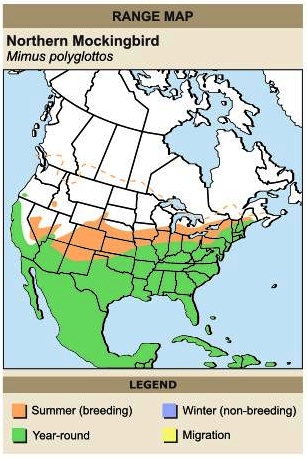
Medium-sized mockingbird
with gray upperparts, paler gray underparts,
and thin black mask. Wings are gray-black with two white bars and large
white patches visible when spread.
The tail is long, gray, and edged with white. Legs and feet are black.
Feeds on fruit and insects.
The adult Northern Mockingbird has gray upperparts, pale gray underparts
and a thin black mask. The wings are gray-black with two white bars
and
large white patches visible when spread.
|
NORTHERN
MOCKINGBIRD
Mimus polyglottos
PASSERIFORMES
Mockingbirds and Thrashers (Mimidae)
Range and Habitat
Breeds from northern California, eastern Nebraska, southern Ontario,
and Maritime Canada southward. Spends winters in the southern part of
range. Found in residential areas, city parks, farmlands, open country
with thickets, and desert brush.
SOUND: "chack"

The Northern Mockingbird is the state bird of Arkansas,
Florida, Mississippi, Tennessee, and Texas.
The often observed behavior of birds flashing their white wing patches
is still unexplained. Theories include it being used to startle prey
or intimidate predators.
The Northern Mockingbird voraciously defends its territory, attacking
intruders including house pets and even people.
A group of mockingbirds has many collective nouns,
including an "echo", "exactness", "plagiary",
and a
"ridicule" of mockingbirds.

The Northern Mockingbird has a large range, estimated globally at 10,000,000
kilometers. Native to the North America and nearby island nations and
territories, this bird prefers temperate, subtropical, or tropical forest
and shrubland ecosystems as well as rural gardens and degraded former
forest areas.
|




